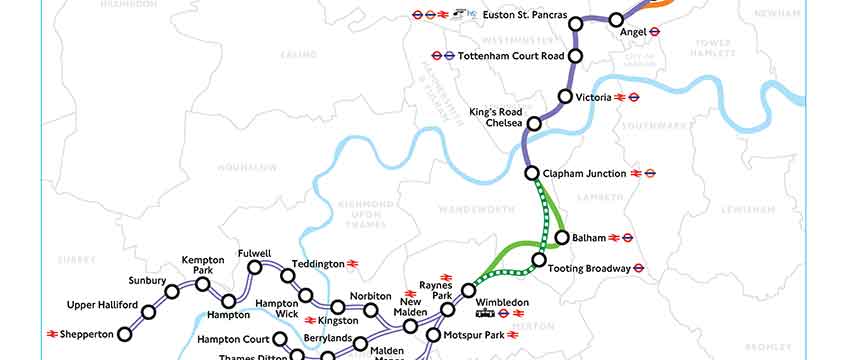On the desk of Chris Grayling, the Transport Secretary, lies a document almost as weighty as the Great Repeal Bill: the business case for Crossrail 2, writes Tony Pidgley.
In the midst of a snap General Election campaign focused on Brexit, it could be easy to forget the magnitude of other decisions we need to make about this country – about our economy, housing, and our transport system, including Crossrail 2.
CR2 is a new rail line running north to south across London, from Wimbledon to Tottenham Hale. It is one of just a handful of infrastructure projects around the country that could dramatically boost the UK’s competitiveness. It could transform the lives of millions of people. And now it needs the approval of Mr Grayling and the chancellor before it can move to the next stage.
Personally, I don’t believe Brexit will diminish London. In fact, I think London will continue to flourish after 2019. But as the population continues to grow, the transport system will come under immense pressure.
By 2030, travelling on most of the Tube network could be unbearable. Commuters across the South East could be crammed even tighter on to trains. Overcrowding and station closures could become routine. Unless we act now, the South East faces gridlock.
Crossrail 2 lies at the heart of the solution. It would boost London’s rail capacity by 10% and ease the pressure on regional lines, north into Hertfordshire and south towards Hampshire. If ministers give CR2 the green light this year, tunnelling can commence in the early 2020s – which means trains running by 2033.
This is not just a railway. Crossrail 2 will revitalise areas of London that have long deserved a much better deal. It will deliver homes, create jobs and help these communities prosper.
Take the Upper Lea Valley in north-east London: designated last year by the mayor as an opportunity area but right now served by a skeleton service into Liverpool Street, Angel Road was London’s least-used station last year. What price opportunity if you can’t get to work?

At the other end of the spectrum, we also know that connectivity can transform communities. Just look at the Elizabeth Line in Woolwich. Suddenly we see investment, energy, ideas, and aspiration.
TfL predicts that if trains run every few minutes during the day, the Upper Lea Valley could accommodate 50,000 new homes – a number that is twice what London currently delivers in a year and is an incredible prize for a region fighting to address a housing crisis.
This one decision could give us around 200,000 additional homes, 200,000 jobs in London, up to 60,000 jobs across the UK and around 18,000 apprenticeships, and could add £150bn to the UK economy.
But to my mind, this is about more than just numbers. London is the world’s gateway to Britain. If we are serious about being a great trading power post-Brexit, we need to invest for the future – starting with Crossrail 2.
Tony Pidgley is chairman of the Berkeley Group and president of London Chamber of Commerce and Industry
Analysis: Crossrail 2, where now?
Provided the business case sitting before the Department for Transport is approved by Chris Grayling, a hybrid bill would be prepared and submitted to the next parliament, writes Alexander Peace.
While this sounds very soon, it still means years of planning.
The original Crossrail Bill took three years to work its way through parliament, finally receiving assent in 2008 after its submission in 2005. The first sections are due to open next year, with others following in 2019.
For Crossrail 2, provided all goes to plan, this would mean construction starts in the 2020s, and the passenger carrying service starts in 2033.
TfL says that the new line will address capacity constraints on congested sections of the London Underground and mainline railways, and will reduce crowding on the lines affected by up to 30%. On some lines it will increase capacity by about 65%, says TfL.
Crossrail 2 is also being designed with residential uplift in mind. TfL says the line will increase connectivity into areas of prospective future housing growth.
Initial estimates have claimed the line could support 200,000 new homes, which will reinvigorate stations along its route from Haringey to Norbiton.
That growth is big business. JLL estimates that stations along the route of the original Crossrail will see house price growth 19% above the London average between 2014 and 2020. TfL estimates land values will increase by £60bn along the route.
The challenge now is to use that increase in value to pay for the development. While a potential bill works its way through parliament, that will be one of the things TfL concentrates on.
The entire scheme is set to cost £31.2bn. It is hoped around half the costs will be covered through existing funding streams such as enhanced mayoral CIL and a continuation of the business rates supplement.
But TfL, and the government for HS2, is also looking at ways to access the uplift that landowners receive.
While stamp duty and business rates are two options, TfL is also consulting on a development rights auction model, where land around a station is pooled together and sold, and even the private development of stations and rolling stock.
The development of Crossrail 2 is hopefully a foregone conclusion; paying for it most certainly is not.
alex.peace@egi.co.uk or @EGALexPeace or @EstatesGazette











